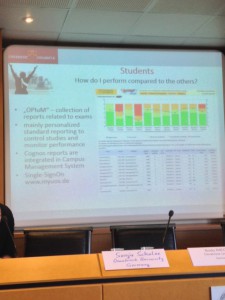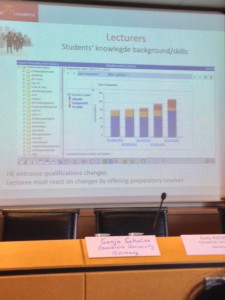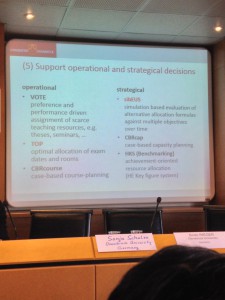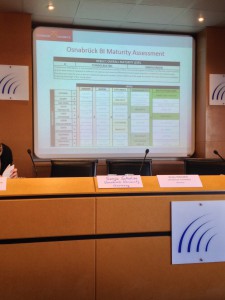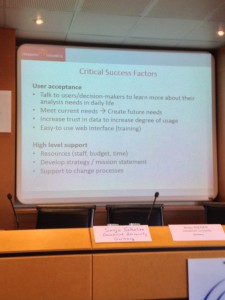Next up at the EUNIS BI Conference it’s Targets, Implementation, Experiences, Recommendations from Osnabrueck University. Bodo Rieger and Sonja Schulze.
15 years of BI initiative to report here in 30 minutes. I’m strapped in and ready!
This is an IBM Cognos implementation over Oracle with 5 objectives;
Address all levels of decision making
Integrate qualitative and quantitative data
From all operational systems
Provide standard and analytics reporting
Support operational and strategic decisions
Not all have been met!
There are four user group targets; Students (seen as the most important), Lecturers, Faculty Management, Top Management.
A popular dashboard allows personal benchmarking by students against student exam performance updated when new results are added (not on demand).
One for lecturers here showing red where incoming students have a lower level of education and will need additional support.
Accurate predictions of likely demand for course registration from students allows forward resource planning. Decision support systems improve resource allocation by assigning scarce resources to students to assist in timetabling.
There’s something in here on utilising a mixture of visualisation, text and hypertext allowing query and presentation of the data. Another interesting feature is to ensure that nominated data owners are able and expected to clean up the data where errors are identified. The system has over 10K users (skewed as it has student access).
They started with analytics reporting giving all the suers cubes to analyse the data as people wanted. This was NOT successful. Standard reporting was the way to go. They’re now bringing cubes back in as readiness is achieved.
Here are some examples of strategic decisions
Benchmarking is done using national data sets based on mandatory returns. This is a parallel with the UK situation and one for follow up.
They have an example of complex realtime modelling to optimally assign exam dates and rooms – smart predictive timetabling ensures students aren;t over burdened and room allocation is optimal.
Here’s the Osnabruck BI Maturity;
Here’s an example of success factors based on user acceptance
